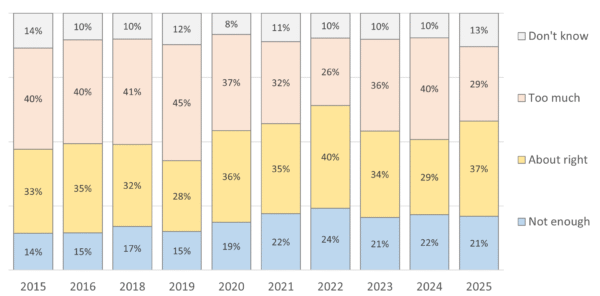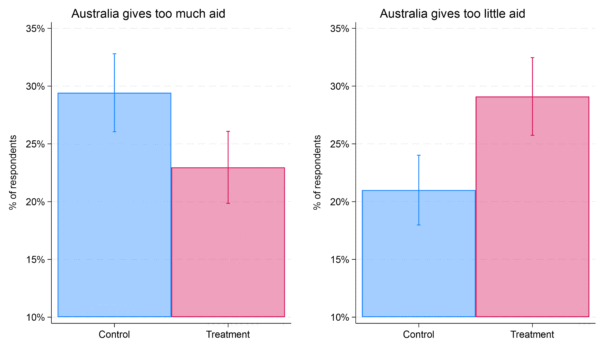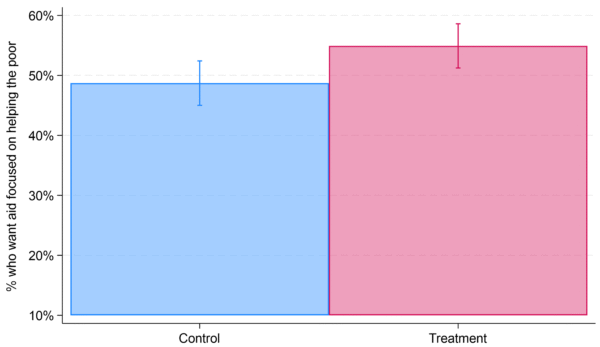Have Trump’s cuts made Australians kinder? 2025 aid attitudes survey
August 28, 2025
Aid hasn’t been an easy sell in Australia. In all the surveys we’ve run since 2015, more respondents have thought Australia gave too much aid than thought it gave too little. In our 2024 survey, 40% of respondents said Australia gave too much, while only 22% said it gave too little.
Change is afoot though. In our 2025 survey – run by Ipsos using a nationally representative sample of 700 people – the percentage of respondents who said they thought Australia gives too little aid was unchanged. However, as Figure 1 shows, the share who think their country gives too much has fallen a lot, from 40% to 29%. Only once in the last 10 years – 2022 – has hostility to aid been lower.
Figure 1: Results from Development Policy Centre surveys on Australian attitudes to aid

Source: 2025 Development Policy Centre aid attitudes survey.
Notes: The survey question in 2025 was “Every year the Australian government gives aid money to poorer countries. Currently less than $1 out of every $100 of federal government spending is given as aid. Which one of the following options best reflects your opinion about aid spending?” The 2025 data come from the control group described in the experiment below. You can download the chart data here.
The most likely explanation for the change since last year is economic circumstances: inflation is down, interest rates are coming down and unemployment is still lower than it was pre-Covid. It’s likely that Australians feel that their own circumstances are improving and so are less hostile to helping overseas.
There is of course, an alternative explanation, one stemming from outside of Australia’s borders: Donald Trump. Inspired by his erstwhile buddy Elon Musk, Trump has slashed the US aid budget. The consequences of this are already being felt. Possibly Australians have become more favourably disposed to aid because they have heard about US cuts?
We doubt this is the case. Australians’ 2025 attitudes to aid are similar to those in 2022, which was long before this year’s cuts. Also, although we development types know about the cuts, people outside of our circles often pay very little attention to aid-related news.
What’s more, as part of a survey experiment, we randomly allocated a second group of 701 people to receive a “treatment”, which involved them reading about US aid cuts in a short newspaper-style article (the article is here).
Because allocation was random, the second group was nearly identical to the control group, who did not read the article, and whose views are summarised in Figure 1 above. This meant that any difference in opinions can only have stemmed from the treatment: reading about the cuts. And, indeed, the treatment group’s opinions were very different.
Figure 2 below shows the proportion of respondents who thought that Australia gave too much aid (left panel) and the share who thought it gave too little aid (right panel). The attitudes of the control group, who were not given the article, are shown in blue. The attitudes of the treatment group, who were given the article, are shown in red.
The difference between the two groups – the effect of reading the article – would not have been large if people already knew a lot about the US cuts. More than this though, the experiment showed just how effective telling people about the impacts of the US cuts can be at shifting Australians’ attitudes to aid.
Figure 2: The impact of telling people about the potential consequences of US aid cuts on Australians’ views on aid volume

Source: 2025 Development Policy Centre aid attitudes survey.
In previous experiments, we have been able to change people’s views about whether Australia gives too much aid. It has been harder to change their views about whether it gives too little though. For this reason, the change in the second panel – an increase of 8 percentage points – is particularly striking. Also, amongst those who read the article, more people said they thought Australia gave too little aid than said they thought it gave too much, something that has never previously been the case in our surveys. The fact that a simple 144 word article could change people’s attitude to this extent, speaks to the potential for a more concerted messaging campaign.
Why did people’s attitudes changed so much? Was it because they were worried about Australia’s national interest in a world where China is supposedly on the rise and US aid in rapid retreat? Or was it because they were worried about the harm declining US aid will do to the poor?
Because of the nature of the experiment, we weren’t directly able to test how the article altered people’s views. However, we did ask people why they thought Australia should be giving its aid: to advance its own interest or two help people living in developing countries. Figure 3 shows the effect of the article on the share of people who think Australia should give its aid to help developing countries.
As the chart shows, the treatment article clearly increased the share of people who wanted Australian aid focused on helping poor people rather than advancing Australia’s interests. Hearing about US aid cuts not only makes Australians favour more aid. It also leads to more of them wanting their aid to help people in need.
Figure 3: The impact of US aid cuts on Australians’ views about the purpose of aid giving

Source: 2025 Development Policy Centre aid attitudes survey.
Chart notes: The question was, “Do you think Australian government aid to poor countries should be given primarily for the purpose of helping people in poor countries, or do you think Australian aid should be given primarily to help advance Australia’s commercial and strategic interests?”
Australians are less hostile to aid than they were a year ago. While the reasons behind that change are, we think, largely to do with the economy, telling people about US cuts increases support for Australian aid considerably. It also increases the share of Australians who want their aid focused on helping the poor.
Disclosure
This research was undertaken with the support of the Gates Foundation. The views represent those of the authors only.
Republished from DEVPOLICY BLOG, 27 August 2025
The views expressed in this article may or may not reflect those of Pearls and Irritations.
